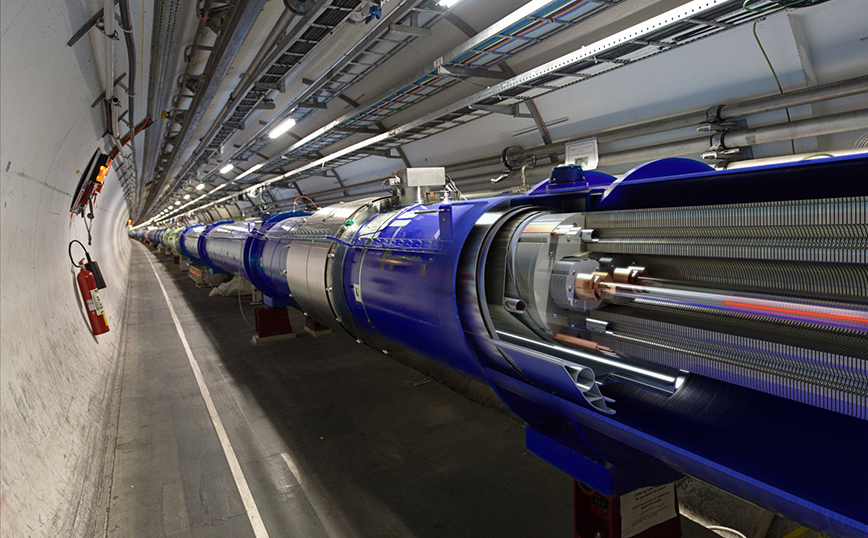
THE CERNthe Large Hadron Collider (LHC) of the European Center for Nuclear Research, the world’s largest and most powerful ever, will officially start today the new data collection period from collisions of subatomic particles (LHC Run 3) with more energy than ever before (13.6 TEV or teraelectronvolts). CERN had been shut down for three years in order to maintain itself.
The limited trial run of the accelerator started in April and now it’s time for the official full relaunch. The LHC will operate non-stop for about four years, during which physicists look forward to new important discoveries, probably of similar scope to the discovery of the Higgs boson ten years ago.
Two beams of protons – particles in the nucleus of the atom – will travel at almost the speed of light from opposite directions and collide inside the 27km-long underground accelerator 100m below the French-Swiss border. The collisions will be recorded and analyzed by thousands of scientists from many countries (including Greece), who make up the groups of experiments, reports APE-MPE.
“We aim to achieve 1.6 billion collisions between protons per second,” said Mike Lamont, CERN’s head of accelerators and technology. In relation to its first period of operation accelerator (Run 1), it is estimated that about 20 times more collisions will be achieved this time.
Already the four major experiments (ATLAS, CMS, LHCb and ALICE) using the large accelerator have upgraded their own detector systems, which will now allow them to collect significantly larger and better quality data samples from the collisions.
Among other things, scientists will further study the nature of the Higgs boson, the origin of matter-antimatter asymmetry in the universe, the properties of matter under extreme conditions of temperature and pressure, while some dream of finally solving the mystery of “dark” matter.
The “God Particle”
The two independent international scientific teams of the ATLAS and CMS experiments released on July 4 – on the occasion of the exact ten-year anniversary of its discovery Higgs particle (as of July 4, 2012) – the most comprehensive studies to date of the properties of the “God particle”.
Their two publications in the journal Nature show that these properties are remarkably compatible and consistent with those predicted for the boson in question by the Standard Standard, the “bible” of particle physics. Studies also show that the particle is increasingly becoming a powerful tool for searching for new unknown phenomena that – if eventually found – will shed light on mysteries such as the nature of dark matter.
The Higgs boson is the particle manifestation of a ubiquitous quantum field known as the Higgs field, which is fundamental to the description of the known universe. Without it, elementary particles such as quarks (components of the protons and neutrons of atomic nuclei), as well as the electrons surrounding the nucleus, would have no mass, and so would heavy particles (W bosons), which are carriers of the weak nuclear force.
Further study of the particle and the Higgs field will become possible through the new round of collisions at CERN over the next four years and, even more so, after the expected new major accelerator upgrade after 2029 (High-Luminosity LHC or HL-LHC). Among other things, the first observations of how the Higgs boson interacts with itself are expected. Other questions also beg to be answered, such as whether the Higgs particle is indeed elementary or a composite of others, as well as whether it is the only one or if there are other similar particles in nature.
Also the smaller ones experiments in the big accelerator (TOTEM, LHCf, MoEDAL-MAPP, FASER and [email protected]) are set to explore in the coming years various phenomena within the Standard Standard of Physics and beyond, from magnetic monopoles to neutrinos and cosmic rays. In the far future, scientists are making plans for a larger Future Circular Collider, a 100 km ring that will operate at energies of 100 TEV.
The official start of the new season of LHC Run 3 will be broadcast in the afternoon live by CERN via its social media channels (with a start time of 17:00 Greek time).
Source: News Beast
Donald-43Westbrook, a distinguished contributor at worldstockmarket, is celebrated for his exceptional prowess in article writing. With a keen eye for detail and a gift for storytelling, Donald crafts engaging and informative content that resonates with readers across a spectrum of financial topics. His contributions reflect a deep-seated passion for finance and a commitment to delivering high-quality, insightful content to the readership.







